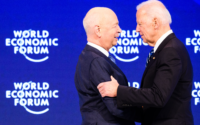Central bank gold purchases highest in more than half a century
It has not attracted much attention in the financial press but the World Gold Council (WGC), a think tank and lobby group for the industry, has reported that purchases of the precious metal, once the basis of the international monetary system, were the highest in 2022 for 55 years.
The buying surge has been led by Russia and China with a number of smaller countries also increasing their holdings. It appears to be a response to two developments—the freezing of the Russian central bank’s dollar holdings after the invasion in Ukraine and growing uncertainty over the stability of US financial markets and its political system.
Reporting on the gold buying moves, the Financial Times (FT) cited the remarks of Adrian Ash, head of research at BullionVault, a gold trading firm.
He said the move to gold “would suggest the geopolitical backdrop is one of mistrust, distrust and uncertainty” in the wake of the freezing of Russia’s dollar assets.
Nicky Shiels, a strategist at MKS PAMP, a precious metals trading company, underscored the same issue in comments to the FT.
She said the sanctions, which froze $300 billion of Russia’s assets, had prompted nations outside the West to ask: “Should we have exposure to so many dollars when the US and Western governments can confiscate that at any time.”
The WGC estimated that in 2022 world official financial institutions bought 673 tonnes of gold. Some 400 tonnes were purchased in the third quarter alone, the largest amount in a three-month period since quarterly records began in 2000.
Russia has ceased issuing monthly data on its purchases, but it is widely believed to be active in the market. The Central Bank of Russia has said previously that it would be desirable for gold to comprise up to 25 percent of its reserves.
The People’s Bank of China reported that in November it made its first increase in gold holdings since 2019, buying 32 tonnes worth around $1.8 billion. Major buyers in the third quarter were Turkey, Uzbekistan and Qatar.
In its report on the surge in gold buying, the FT noted: “The last time this level of buying was seen marked a historical turning point for the global monetary system. In 1967, European central banks bought massive volumes of gold from the US, leading to a run on the price and the collapse of the London Gold Pool of reserves. This hastened the eventual demise of the Bretton Woods System that tied the value of the US dollar to the precious metal.”
Under the Bretton Woods System, established in 1944 in order to stabilise the global financial system after its virtual collapse in the 1930s, the dollar essentially became the global currency. But it had a material foundation in that the dollar was redeemable by the US for gold at the rate of $35 per ounce.
Problems began to emerge in the system in the 1960s due to a contradiction at its very centre. World trade and finance depended on the continued outflow of dollars from the US. But the more offshore dollar holdings increased, the greater the discrepancy between these amounts and their gold backing held in the US.
This contradiction was covered over in the 1950s when the US, because of its vast industrial power, enjoyed a positive balance of trade. But the rise of other major powers, after they had recovered from the devastation of the war, meant that the global trade position of the US was weakened and when the balance of trade turned negative US president Nixon removed the gold backing from the dollar. The gold window was closed.
For the first time in history, world trade and finance rested entirely on a fiat currency, that is, one without a backing in gold or any other material asset.
The result was a surge of inflation igniting a major upsurge of the working class during the 1970s.
One of the major geopolitical consequences, evident most clearly in the recent period as the US has increasingly turned to military means to achieve its strategic objectives, has been the “weaponisation” of the dollar.
Under Bretton Woods, the US was always constrained by the fact that its rivals could exert pressure on Washington by turning their dollar holdings into gold, as French President de Gaulle did in the 1960s.
But in today’s financial system that option does not exist. Countries or corporations which engage in trade or investment deemed to be contrary to US interests can be cut out of the financial system through the imposition of sanctions by Washington, crippling their global operations.
This method has been used to pressure European countries and businesses which want to trade with Iran in defiance of US sanctions. They have been forced to comply under the threat they will be excluded from financial operations based on the dollar.
The threat of exclusion also hangs over those who might seek to defy the high-tech sanctions imposed by the US against China.
Weaponisation made a qualitative leap with the freezing of Russia’s assets. It signified that the unimpeded flow of finance and trade—the nostrum of the “free market”—was a fiction.
There is another factor at work. The dollar functions as the global currency and is regarded as a store of value and a means of facilitating international transactions. This is true not only in trade but above all in finance.
However, the dollar is not grounded on a material foundation. It is sought after because it is regarded as a store of value and is considered to be a store of value because it is eagerly sought after.
In other words, its global role rests on confidence in its stability. But that confidence has been severely shaken in the past 15 years, beginning with the global financial crisis in 2008, which was sparked by the rot and decay at the very heart of the American banking system, produced by speculation and in some cases outright criminal activity.
It was shaken again in March 2020, at the start of the pandemic, when the $24 trillion US Treasury market, the basis of the global financial system, froze. A full-scale collapse was only prevented by the pouring in of trillions of dollars by the US Federal Reserve.
Consequently, there has been a small, but nonetheless significant, shift away from the dollar as the key reserve currency. In a blog post last June, the International Monetary Fund (IMF) noted that while the dollar still dominated trade, bond issuance and international lending and borrowing, “central banks aren’t holding the greenback in their reserves to the extent that they once did.”
According to the IMF, the dollar’s share of global currency reserves “fell below 59 percent in the final quarter of last year [2021], extending a two-decade decline.”
Political factors are also no doubt playing a role. The dollar’s preeminent global role depends on confidence not only in its economic foundations but in the stability of its political system. That confidence has been undermined by the coming to power of Donald Trump, his near successful coup attempt of January 6, 2021, and the ongoing political crisis since then.
The buying of gold at the highest levels in more than five decades does not, at least to this point, signify a collapse of the dollar-based financial system and the mountain of debt built on it. But it does point to underlying shifts in the financial tectonic plates that could have major consequences in the future.
Another indication of the shift away from the dollar is the move by China to buy oil and natural gas from Iran, Venezuela, Russia and parts of Africa in its own currency, the yuan (renminbi).
According to Credit Suisse analyst Zoltan Pozsar, whose recent note to clients was reported in the FT, the meeting between Chinese president Xi Jinping and Saudi and Gulf Co-operation leaders in December marked “the birth of the petroyuan.”
China’s objective, he said, was to “rewrite the rules of the energy market” to de-dollarise sections of the world after the freezing of Russia’s foreign exchange reserves.
A letter to the newspaper, which it chose to feature, pointed to a move by Ghana to make payments for oil in gold rather than dollars.
The writer said one should not infer too much from one small country “getting creative with money.” However, if Ghana’s problems were “reflective of the wider issue of global dollar reliance,” it suggested that “gold is being used for its money-like qualities in a way that has seemed unfashionable for much of the past 50 years.”
He concluded with the observation that the surge in gold purchases in the third quarter of last year made one wonder “if this portends moves afoot in the world, if not to replace the dollar as the world reserve currency, at least to chip away at its dominance at the fringes, with all the geopolitical implications that come with this.”
[ad_2]
Source link


